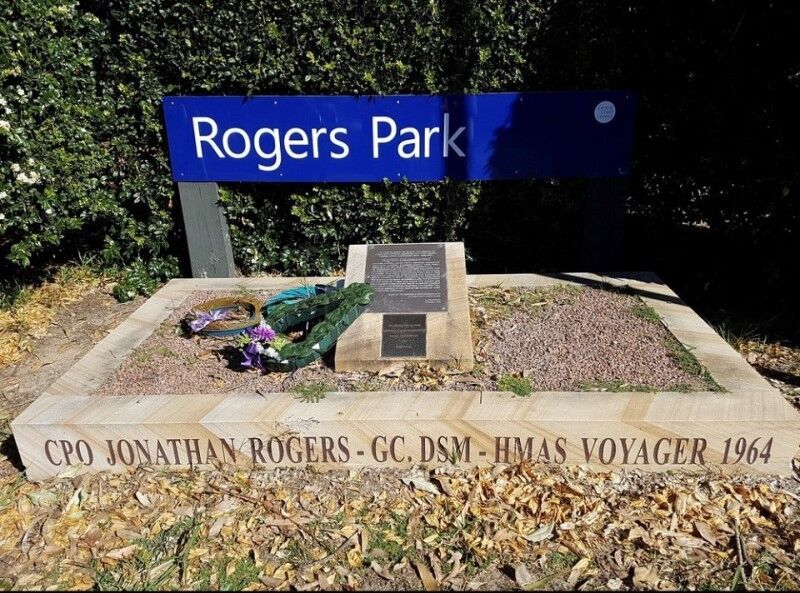
Chief Petty Officer Jonathan RogersPrint Page 

The park commemorates Chief Petty Officer Jonathan Rogers (1920 - 1964) who was killed in the collision between H. M. A. S. Voyager and H. M. A. S. Melbourne in February 1964.
Jonathan Rogers was born on 16 September 1920 at Vroncysylite in Wales, On 22 November 1938 he enlisted in the Royal Navy, and spent most of World War Two at sea in three coastal vessels : Motor Anti-Submarine Boat No.62 (1940 - 41), Motor Launch No.204 (1942 - 43) and Motor Torpedo Boat No.698 (1943 - 45). Promoted petty officer in 1943, he was awarded the Distinguished Service Medal for his 'coolness and leadership' under enemy fire during an action off Dunkirk, France, on the night of 23 - 24 May 1944. He was discharged from the Royal Navy on 23 January 1946.
In 1950 he applied to join the Royal Australian Navy. He was accepted on 6 July and posted to the aircraft-carrier H.M.A.S. Sydney; his next ship was the frigate Burdekin. Service (1952-54) in the destroyer H. M. A. S. Tobruk took him to Korean waters. He was promoted chief petty officer in 1956.
In January 1963 Jonathan 'Buck' Rogers joined the destroyer H. M. A. S.Voyager. As her coxswain, Rogers was the senior sailor on board and responsible for the 'good order and discipline' of the ship's company. On 10 February 1964, H. M. A. S. Voyager took part in exercises with the aircraft-carrier H. M. A. S. Melbourne off the south coast of New South Wales. That evening Rogers presided over a game of tombola being played by about sixty men in the ship's forward cafeteria. At 8.56 p.m., 37 kilometres south-east of Jervis Bay, H. M. A. S. Voyager collided with H. M. A. S. Melbourne and was cut in two. Voyager's severed forward section immediately heeled sharply to starboard and about five minutes later turned upside down. Water began pouring into the cafeteria. Within another five minutes the forward section sank. Rogers was one of the eighty-two men who died. His wife, son and three daughters survived him.
Sailors who escaped from the cafeteria later told how Rogers had taken charge of the situation. He had calmed terrified shipmates, attempted to control the flooding, tried to free a jammed escape hatch with a length of pipe and a spanner, and organized men to move into other compartments with functioning emergency exits. Meanwhile, he knew that he was probably too large to fit through an escape hatch himself. When it was obvious that some of his comrades would not get out in time, he led them in prayer and a hymn, 'encouraging them to meet death' beside him 'with dignity and honour'. He was posthumously awarded the George Cross.
Location
| Address: | Dunban Road, Rogers Park, Woy Woy, 2256 |
|---|---|
| State: | NSW |
| Area: | AUS |
| GPS Coordinates: | Lat: -33.499271 Long: 151.317178 Note: GPS Coordinates are approximate. |
Details
| Monument Type: | Park |
|---|---|
| Monument Theme: | People |
| Sub-Theme: | Tragedy |
| Actual Event Start Date: | 10-February-1964 |
| Actual Event End Date: | 10-February-1964 |
Dedication
Rogers Park
CPO Jonathan Rogers - GC. DSM - HMAS Voyager 1964



